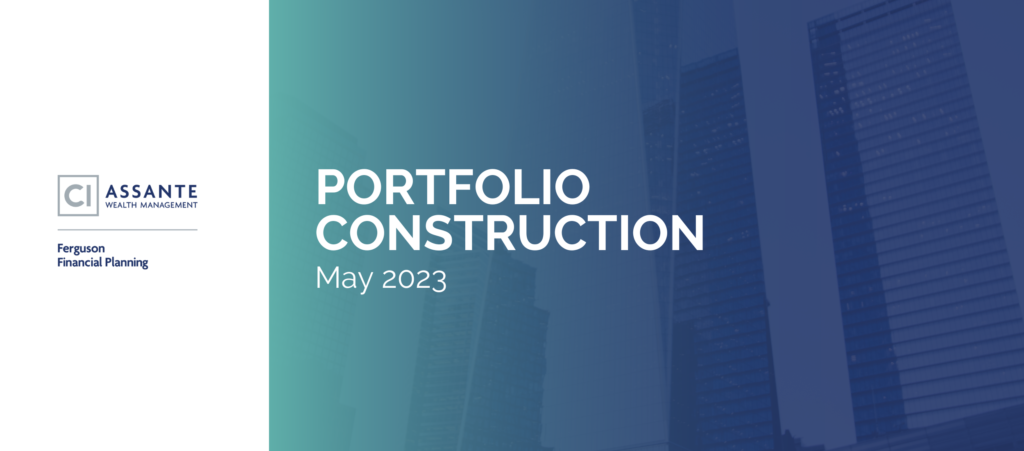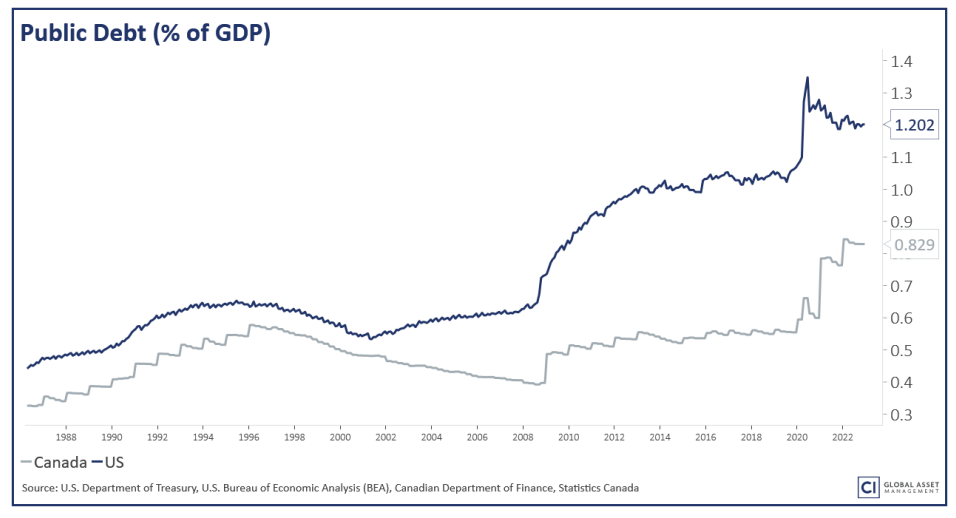May 2023 Portfolio Construction

By Alfred Lam, CFA, Senior Vice-President, and Head of Multi-Assets, CI Global Asset Management.
Is the U.S. Print-To-Pay Policy Coming to an End?
In our lives, we often deal with uncertainties. Some are “known unknowns”, meaning we were aware of the event/issue but uncertain about the outcome; some are “unknown unknowns”, meaning no one saw it coming, it was sudden and random, like the COVID-19 outbreak in 2020. Today, the news is focused on the U.S. debt ceiling, which falls squarely in the “known unknown” category as it’s an issue that has been building for years. Intuitively, the U.S. government should not be allowed to default, and their borrowing limit should be increased such that bills are paid and Americans’ lifestyles can be maintained.

The reality is the debt ceiling was created for good reason. At the least it serves to ensure the government is sensible about its spending and debt level. To put debt in context, debt-to-GDP is a more sensible measure as debt is compared to the economy which ultimately correlates to potential tax that the government collects. As the chart above illustrates, U.S. debt-to-GDP has been growing and was 120% as of Dec 31, 2022; comparatively, the Canadian government has been more responsible with borrowing as its ratio was “only” 83%.
As you are aware, the U.S. economy has been growing at a rapid rate (partly due to inflation) with unemployment also at a decades-low level, meaning there are more taxpayers than normal, hence revenue for the government is above trend. Even then, the government is running an annual deficit. Is the U.S. deficit temporary? Unlikely, as mandatory spending accounts for almost all of the tax revenue, leaving some discretionary spending and interest payments to be paid via additional borrowing. If the situation is applied to a business or individual, they are unlikely to get new funding. Governments, however, have two powerful tools: taxing and printing money. For many reasons, it is unpopular to raise
tax. The alternative, printing money, has led the U.S. Federal Reserve balance sheet to expand from less than $1 trillion 15 years ago to now over $8 trillion through purchases of U.S. sovereign bonds. During the same period, U.S. debt has nearly tripled. As the government spends more than it collects in taxes, it issues bonds to raise revenue. Some of the bonds are bought by private investors and a lot were actually bought by the Fed. In summary, the U.S. government funds itself through its agent, the Fed, which actually has no assets to begin with.
It seems printing money solves all issues, including the latest banking crisis. Depositors had a run on several U.S. regional banks in March and April as they were concerned about the health of some banks and wanted to get paid back immediately. The “crisis” ended with the U.S. Treasury and the Fed expressing their intent to guarantee all deposits. No one doubted their ability to follow through on this as they own the privilege to print.
So, does printing money solve all issues? The answer is no. Based on past experiences, it has led to two outcomes. Following a large amount of printing in 2009 to fix the global financial crisis, the U.S. economy had years of sluggish growth and an unequal distribution of wealth. Recently, following very aggressive printing to offset the economic impact of COVID-19, we have had a period of very high inflation. There could be a third outcome if the U.S. government continues this route of print-to-pay, rather than earn-to-pay or spend less: investors could lose confidence in the U.S. monetary system, U.S. sovereign bonds, and the U.S. dollar. At the moment, it is a low probability event, but still possible.
The current event, the U.S. debt ceiling debate, will likely be resolved at the final hour, which is expected to be sometime in June when the U.S. government runs out of borrowing capacity. In U.S. history, asking for a raise is not uncommon. As the size of an economy grows, it is sensible to grow its borrowing capacity. That principle requires little debate. The problem this time is the U.S. debt-to-GDP ratio has been high and rising since 2008. The last few U.S. presidents made no effort to address this.
U.S. President Joe Biden insists the raise must be unconditional. As a lender, would you want to lend to someone who has no plans to fix a budget deficit?
If Congress does not approve a raise, the U.S. may still pay its debt as it is critical to maintain its credit rating and financial stability. However, civil servants may not get paid and social benefits may be suspended, at least for some time. This will create dramatic challenges to Americans’ lifestyles and have an immediate negative impact on the U.S. economy and stock valuations, and in turn lower U.S. tax revenue. Consequently, growing deficit and debt. If the debt ceiling is raised without conditions, the immediate response will probably be positive as it means the “party” continues. However, as we
mentioned, this strategy carries the risk of loss of confidence in the system. It will take time to fully play out, and the damage may filter through very slowly. Investors should be mindful about this debt ceiling event, but not over-react.
Disclaimer
This document is intended solely for information purposes. It is not a sales prospectus, nor should it be construed as an offer or an invitation to take part in an offer. This report may contain forward-looking statements about one or more pools, future performance, strategies or prospects, and possible future fund action. These statements reflect the portfolio managers’ current beliefs and are based on information currently available to them. Forward-looking statements are not guarantees of future performance. We caution you not to place undue reliance on these statements as a number of factors could cause actual events or results to differ materially from those expressed in any forward-looking statement, including economic, political and market changes and other developments. Every effort has been made to ensure that the material contained herein is accurate at the time of publication. Market conditions may change which may impact the
information contained in this document and it is subject to change without notice. The author and/or a member of their immediate family may hold specific holdings/securities discussed in this document. Any opinion or information provided are solely those of the author and does not constitute investment advice or an endorsement or recommendation of any entity or security discussed or provided by CI Global Asset Management.
We cannot guarantee its accuracy or completeness and we accept no responsibility for any loss arising from any use of or reliance on the information contained herein. The pools used in the CI Private Wealth portfolios are managed by CI Global Asset Management. Management fees and expenses may all be associated with investments in the CI Private Wealth portfolios and the use of other services. The pools used in the CI Private Wealth portfolios are not guaranteed, their values change frequently, and past performance may not be repeated. You should seek professional advice before acting on the basis of information herein. Commissions, trailing commissions, management fees and expenses all may be associated with mutual fund investments. Please read the prospectus before investing. Mutual funds are not guaranteed, their values change frequently, and past performance may not be repeated. CI GAM | Multi-Asset Management is a division of CI Global Asset Management. CI Global Asset Management is a registered business name of CI Investments Inc. This report may not be reproduced, in whole or in part, in any manner whatsoever, without prior written permission of CI Private Wealth. © 2023 CI Private Wealth, a division of CI Private Counsel LP. All rights reserved.

